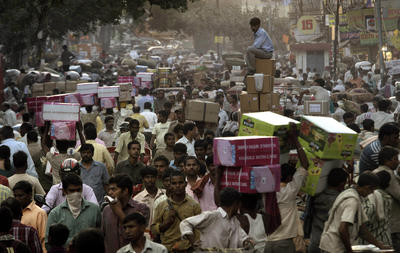Subsidised food grains, for example, can otherwise achieve broad coverage, and are supplied through the Public Distribution System (PDS) to 180 million poor. This occurs through a network of half a million licensed shops at an annual subsidy of Rp400 billion (US$8 billion). But nearly 40–50 per cent of the subsidy gets wasted on undeserving people: ‘non-poor’ people who obtain a card entitling them to subsidised food; poor that inflate the number of members in their family; and through cards in the names of nonexistant people. Such fraudulent entitlement is often obtained by committing acts of bribery.
The Unique Identification Authority of India (UIDAI) was created during 2009–10 to issue a 12-digit unique number (called aadhaar) to residents in the belief that these measures would plug the leakages and eventually strengthen national security. But there are many vocal critics of aadhaar who question the creation of a centralised database which may be open to abuse by police and security agencies. Aadhaar is linked to each individual’s basic demographic and biometric information — a photograph, ten fingerprints and an iris scan — stored in a central database, but the number is not classified by caste, creed, religion or location. Citizens’ identity can be verified using hand-held devices linked to the mobile phone network by sending the aadhaar and a finger print to the central database. The UIDAI then promises to give a ‘yes’ or ‘no’ response to verify the individual’s identity within eight seconds. Though possessing aadhaar is not mandatory, obtaining one does require proof of identity, an address and a date of birth. Individuals without identification documents may obtain aadhaar if they are introduced to the issuing agency by an existing participant of the scheme — and nearly 37 million residents have been issued with aadhaar so far.
Two critical steps will determine the program’s success. First is the enrolment of a significant proportion of India’s population and the collection of error-free information. Duplications will also need to be weeded out. This is a difficult technical task, but it should not prove insurmountable given India’s expertise in software and algorithm development. Second is the use of aadhaar by various government departments to authenticate citizens who request a service — no government agency currently uses it as a basis for delivering services. This will require the front-end to electronically capture basic transactions. For example, half a million shops will need to obtain a finger print and seek authentication from the central database through the PDS alone. Keeping the hand-held devices in working condition and training shop owners to use such a device are challenges that have not been overcome in the past.
Experience of electronic service delivery in India is a mixed bag: a citizen-based assessment of 40 large projects shows that the process has become efficient, but the impact on corruption is marginal. Interestingly, nearly 90 per cent of the approximately 100,000 internet kiosks created in rural areas to deliver certificates and licenses are not delivering any government services, and departments at the back-end, where the basic data is maintained and the issuing of certificates is authorised, have not been enabled with information and communications technology. Any procedural reform that reduces the lower bureaucracy’s capacity to delay or deny services has been resisted. In the case of aadhaar, the departments, too, will resist its use on some pretext. In fact, there has been no pilot testing of aadhaar for end-to-end delivery of any service. Critics wonder whether the many technical and implementation issues will be successfully handled, as the task of collecting 12 billion fingerprints and 2.4 billion iris scans is significantly larger than for any existing biometric database in the world.
Aadhaar was also expected to be widely used for opening bank accounts, so that cash subsidies could be transferred to the poor, instead of distributing subsidised food grains and creating state-supported jobs in rural areas. But such a qualitatively different restructuring of the state’s role in the social sector is unacceptable to many people. Moreover, the Reserve Bank of India has thrown a spanner in the works by declaring that aadhaar would not be a sufficient proof of address — other documents would also be needed. Aadhaar began with the promise of making delivery of government services to the poor efficient, convenient and corruption-free. With so many implementation challenges and turf battles ahead, such a promise may be harder to keep than originally anticipated.
Subhash Bhatnager is an Honorary Adjunct Professor at the Indian Institute of Management in Ahmedabad.

